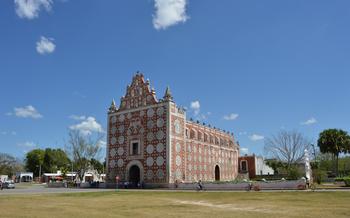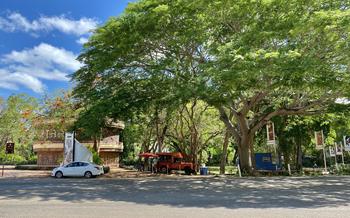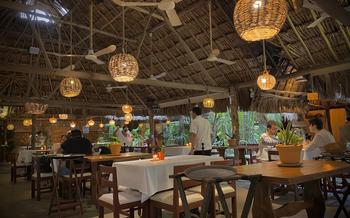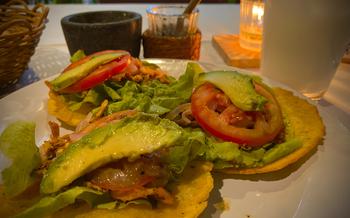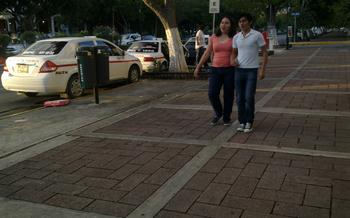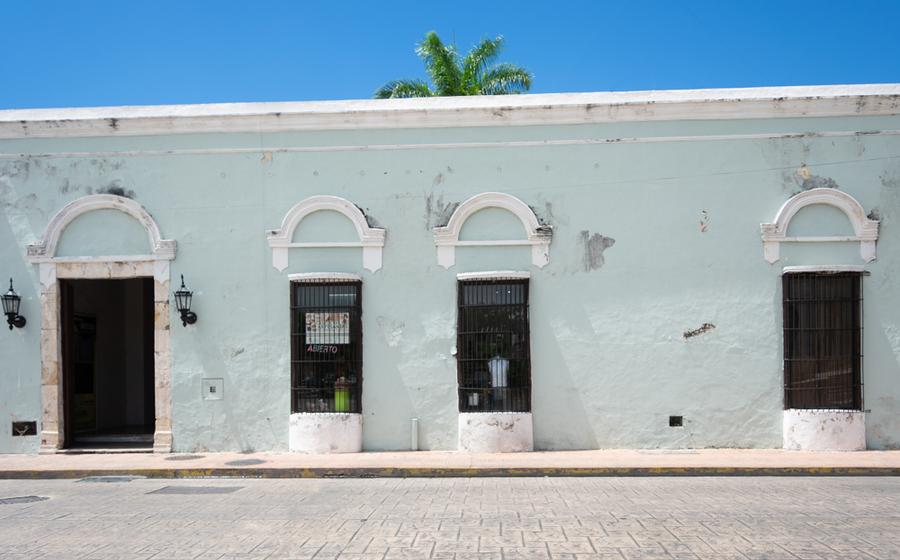
Casa de las Artesanías
- The Casa de las Artesanías: A Treasure Trove of Mexican Craftsmanship
- Location and Getting There
- Opening Hours and Admission Fees
- Navigating the Market: Tips for a Rewarding Visit
- Discover the Art of Silverwork
- Immerse Yourself in Vibrant Textiles
- Explore the Allure of Ceramics
- Uncover Hidden Gems: Wood Carvings and Lacquerware
- Savor the Flavors of Yucatecan Cuisine
- Support Local Artists and Artisans
- Take Advantage of Special Events and Festivals
- Plan a Day Trip to Nearby Haciendas
- Capture the Essence of Mexico Through Photography
- Insider Tip: Hidden Gems Beyond the Main Market
The Casa de las Artesanías: A Treasure Trove of Mexican Craftsmanship
In the heart of Mérida's vibrant city center, nestled within a beautifully restored colonial building, lies the Casa de las Artesanías, a treasure trove of exquisite Mexican craftsmanship. Established in 1973, this renowned market serves as a cultural and commercial hub, showcasing the rich diversity of traditional Mexican crafts from every corner of the country.
The Casa de las Artesanías is not just a market; it is a celebration of Mexico's artistic heritage. Over 200 skilled artisans from across the nation gather under one roof to display and sell their exceptional creations, ranging from intricate silver jewelry to vibrant hand-woven textiles, hand-painted pottery, and whimsical wooden sculptures.
As you step inside the market, you are greeted by a symphony of colors, textures, and sounds, creating an immersive experience that engages all the senses. The air is filled with the gentle hum of artisans diligently working on their crafts, the laughter of satisfied customers, and the melodious tunes of traditional Mexican music playing in the background.
Location and Getting There
The Casa de las Artesanías is strategically located in the heart of Mérida, at Calle 65 #494 between Calle 56 and Calle 58 in the Centro Histórico. This prime location makes it easily accessible by foot, public transportation, or private vehicle.
To reach the market by public transportation, you can take advantage of the city's efficient bus system. Several bus routes stop within walking distance of the market, including the Turibus, which offers a convenient hop-on-hop-off service for tourists. Alternatively, you can opt for the comodidad of a taxi or ride-sharing service, which will drop you off right at the entrance of the market.
If you prefer to drive, there are several parking options available in the vicinity. Public parking lots and on-street parking are both readily available, ensuring that you can park your vehicle safely and conveniently.
Opening Hours and Admission Fees
The Casa de las Artesanías is open to the public from Monday to Saturday, from 9:00 AM to 7:00 PM. It remains closed on Sundays and major holidays. It is advisable to visit the market in the morning for a more relaxed experience and to avoid the afternoon heat.
Admission to the market is free of charge, making it an accessible and affordable attraction for visitors. This allows you to leisurely browse the stalls, admire the craftsmanship, and engage with the artisans without any cost barriers.
Navigating the Market: Tips for a Rewarding Visit
The Casa de las Artesanías can be overwhelming, but with the right approach, you can navigate it like a pro. The market is divided into several sections, each dedicated to a specific type of craft. Take your time to explore each section, and don't be afraid to ask the vendors questions about their products. They are usually happy to share their knowledge and expertise.
To avoid the crowds, try to visit the market early in the morning or later in the afternoon. This is when the vendors are usually more relaxed, and you'll have more space to browse and chat with them. If you're a serious shopper, come prepared to haggle. Bargaining is expected in Mexican markets, and it's a great way to get a good deal. Just be respectful and friendly, and don't be afraid to walk away if you don't like the price.
Discover the Art of Silverwork
Silver crafting has a rich history in Mexico, dating back to the pre-Hispanic era. The indigenous peoples of Mexico were skilled silversmiths, and their techniques and designs were passed down through generations. During the colonial period, silver mining and crafting flourished in Mexico, and the country became a major producer of silver jewelry and other objects.
Today, the Casa de las Artesanías is home to a wide variety of silverwork, from traditional pieces to modern designs. Visitors can find everything from delicate filigree earrings to heavy silver necklaces, as well as silver tableware, decorative objects, and religious items.
The silversmiths who work in the Casa de las Artesanías are highly skilled artisans, and their work is of the finest quality. They use a variety of techniques to create their pieces, including casting, forging, hammering, and engraving. The designs are often intricate and detailed, and the pieces are often adorned with gemstones or other decorative elements.
The silverwork at the Casa de las Artesanías is a testament to the skill and artistry of Mexican craftsmen. Visitors can find unique and beautiful pieces that are sure to become treasured keepsakes.
Immerse Yourself in Vibrant Textiles
Dive into the realm of vibrant textiles at the Casa de las Artesanías and marvel at the intricate embroidery and weaving techniques passed down through generations of Mayan artisans. Hand-woven hammocks, rugs, and clothing showcase a mesmerizing array of colors and patterns, each telling its own story. Discover the symbolism and cultural significance woven into every thread, reflecting the rich heritage and traditions of the Yucatan region.
Explore the Allure of Ceramics
Mexico is renowned for its vibrant ceramic traditions, and Merida's Casa de las Artesanías offers a captivating showcase of these exquisite creations. From the intricate motifs of pre-Hispanic pottery to the colorful hand-painted Talavera tiles, each piece exudes its own unique charm and artistry.
Discover the ancient heritage of Mayan ceramics, where potters have skillfully crafted utilitarian and decorative vessels for centuries. Admire the delicate brushstrokes and intricate designs of Talavera tiles, a fusion of Spanish and indigenous techniques that adorn many colonial buildings in Mexico.
Immerse yourself in the artistry of black pottery from the village of San Bartolo Coyotepec, where skilled artisans transform local clay into captivating pieces with a unique smoky hue. These ceramics are not only visually striking but also carry cultural significance, representing the deep connection between the community and its ancestral traditions.
Uncover Hidden Gems: Wood Carvings and Lacquerware
Amidst the vibrant textiles and ceramics, discover the intricate world of wood carvings and lacquerware at the Casa de las Artesanías. Skilled artisans showcase their mastery in creating wooden sculptures that range from delicate figurines to elaborate masks. Admire the intricate details and symbolism embedded in each piece, often inspired by Mayan mythology and folklore.
Among the must-sees are the traditional alebrijes, fantastical creatures with vibrant colors and whimsical forms. These handcrafted wooden sculptures are a testament to the imagination and creativity of Mexican artisans. Don't miss the lacquered gourds and trays, meticulously adorned with intricate designs and patterns. These decorative items are not only beautiful but also functional, adding a touch of Mexican charm to any home.
Savor the Flavors of Yucatecan Cuisine
No visit to the Casa de las Artesanías is complete without indulging in the tantalizing flavors of Yucatecan cuisine. The market is home to a diverse array of food stalls and restaurants, each offering a delectable selection of traditional dishes that showcase the region's rich culinary heritage.
Among the must-try dishes is cochinita pibil, a slow-roasted pork dish that is marinated in achiote paste and wrapped in banana leaves before being cooked in an underground oven. Panuchos are another popular choice, consisting of fried tortillas filled with black beans and topped with turkey or shredded chicken, tomatoes, and pickled onions.
For a refreshing treat, try agua de chaya, a local beverage made from the leaves of the chaya plant, which is known for its cooling properties. And no meal is complete without a taste of dulces regionales, traditional sweets such as candied fruit, coconut macaroons, and honey-glazed pastries.
The Casa de las Artesanías is a fantastic place to sample the diverse flavors of Yucatecan cuisine. Whether you're looking for a quick snack or a sit-down meal, you're sure to find something to satisfy your taste buds.
Support Local Artists and Artisans
The Casa de las Artesanías is not just a marketplace; it's a platform that supports local artists and artisans, preserving Mexico's rich cultural heritage. By purchasing their creations, you directly contribute to their livelihoods and the continuation of traditional crafts. The market operates on fair trade principles, ensuring that artisans receive a fair price for their work. Embrace the opportunity to interact with these talented individuals, learn about their techniques, and gain insights into their creative process. Your purchase becomes a tangible symbol of your support for their artistry and the preservation of Mexican traditions.
Take Advantage of Special Events and Festivals
Throughout the year, the Casa de las Artesanías hosts a variety of special events and festivals that showcase the vibrant culture and traditions of Mexico. These events are a fantastic opportunity to immerse yourself in the local community and experience the city's lively atmosphere.
During the annual Feria de las Artesanías (Craft Fair), held in December, the market transforms into a bustling hub of activity, with hundreds of artisans from across the region showcasing their latest creations. Live music, traditional dance performances, and food stalls add to the festive atmosphere, making it a must-visit event for anyone interested in Mexican culture.
Other notable events include the Festival del Hanal Pixán (Day of the Dead Festival), which takes place in November, and the Festival de la Candelaria (Candlemas Festival), held in February. These festivals offer a unique glimpse into the local traditions and beliefs surrounding these important holidays.
Participating in these special events and festivals is a wonderful way to connect with the local community, support local artists and artisans, and create lasting memories of your time in Mérida.
Plan a Day Trip to Nearby Haciendas
Venture beyond the city limits of Mérida and immerse yourself in the region's rich history by visiting one of the many haciendas that dot the surrounding countryside. These sprawling estates once served as agricultural powerhouses, and many have been meticulously restored and transformed into charming hotels, museums, and cultural centers.
A popular option is Hacienda Sotuta de Peón, located about 40 kilometers east of Mérida. This beautifully preserved hacienda was built in the 19th century and offers guided tours that provide a glimpse into the daily life of a bygone era. Stroll through the lush gardens, admire the colonial architecture, and learn about the history of henequen, the agave fiber that was once the backbone of the region's economy.
Another worthwhile destination is Hacienda Xcanatún, situated just 5 kilometers south of Mérida. This sprawling estate features a cenote, a natural swimming hole, as well as a museum dedicated to the history of the henequen industry. Take a dip in the refreshing waters of the cenote, explore the museum's exhibits, and savor a delicious meal at the hacienda's restaurant, which serves traditional Yucatecan cuisine.
Whether you choose to visit Hacienda Sotuta de Peón, Hacienda Xcanatún, or another of the many haciendas in the region, you'll be rewarded with a unique and memorable experience. Immerse yourself in the history, culture, and natural beauty of Yucatán as you journey through these architectural gems.
Capture the Essence of Mexico Through Photography
With its vibrant colors, intricate patterns, and friendly locals, the Casa de las Artesanías is a photographer's paradise. Capture the essence of Mexico by snapping photos of the colorful stalls, smiling artisans, and unique handicrafts. Don't miss the opportunity to photograph the market's iconic arched entrance, adorned with intricate tilework and vibrant paint.
Tips for Capturing the Vibrant Colors and Atmosphere:
Use Natural Light: The best time to take photos in the market is during the early morning or late afternoon, when the natural light is soft and warm. This will help you capture the vivid colors of the handicrafts without harsh shadows.
Experiment with Different Angles: Don't just shoot everything head-on. Get creative and try different angles to capture unique perspectives. Shoot from above, below, or even from within the stalls to create dynamic compositions.
Focus on the Details: The Casa de las Artesanías is full of intricate details, from the hand-painted tiles to the delicate silver filigree. Take your time to zoom in and capture these details that make the market so special.
Capture the People: The people of the Casa de las Artesanías are as colorful and vibrant as the crafts they sell. Ask permission before taking their photos, and capture their smiles, interactions, and the pride they take in their work.
Respect Privacy: While taking photos, be mindful of the privacy of the artisans and other visitors. Avoid taking photos that make people feel uncomfortable or that invade their personal space.
Insider Tip: Hidden Gems Beyond the Main Market
While the Casa de las Artesanías is undoubtedly a treasure trove of Mexican craftsmanship, venturing beyond its walls can lead to even more unique and authentic discoveries. Explore the surrounding neighborhoods, such as Santiago and Santa Ana, where you'll find hidden gems like small craft shops, studios, and galleries tucked away in charming alleys and courtyards. Here, you'll have the chance to meet artisans in their workshops, witness their creative process, and find one-of-a-kind pieces that truly capture the essence of Mexico.
Don't hesitate to strike up conversations with locals. They'll be more than happy to share their knowledge of the city and point you towards hidden gems that only they know about. Ask for recommendations on where to find the best handmade shoes, traditional textiles, or unique souvenirs. They may even be able to direct you to workshops where you can learn a traditional craft yourself, such as weaving, pottery, or silverwork. Embrace the opportunity to connect with the local community and gain a deeper understanding of Mexican culture through these authentic experiences.
